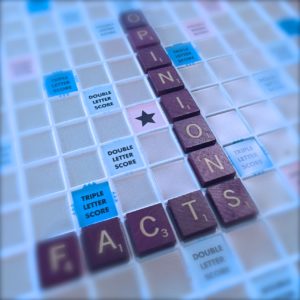By Dr. Ken Broda Bahm: 
Lately, the nation has been divided, again, on a critical question of public policy. And, again, that division reveals some stark differences in the ways each side views the facts and understands the values at stake. This time, the issue involves the policy of forced family separation of undocumented immigrants, including those seeking asylum. To each side, it couldn’t be more clear. For supporters, it’s about enforcing the law and discouraging illegal immigration, and for opponents its about…not taking children away from their parents, particularly if they’re following the law in asking for asylum. But both sides are sure that the other side is wrong on both the facts and the opinions. And for many, that boils down to the same thing: facts and opinions being blurred together, with people being likely to treat their own views as “facts” and contrary views as just “opinions.”
That is one of the conclusions of a new survey. Pew Research Center talked to 5,035 American adults, focusing on a basic question: Are Americans able to tell the difference between facts and opinions? Are they able to correctly differentiate statements that can be confirmed or falsified (facts) and views that can merely be argued for or against (opinions)? The short answer: no, not really. The research participants were given five factual statements and five opinion statements, and were asked to categorize them as either claims of facts or opinions, and to classify them as such whether they agreed with them or not. A majority was able to correctly categorize three out of the five statements, but that was a success rate only a little better than chance. Just 26 percent of adults correctly categorized all facts, and only 35 percent were able to correctly categorize all five opinions. In addition, the researchers balanced the politics of the statements, creating some statements that would appeal to conservatives and some that appeal to liberals. Both sides of the spectrum, however, were likely to label the statements appealing to their own side as “facts,” and to label the statements appealing to the other side as “opinions.” In both cases, this tendency was observed whether the statements actually were facts or opinions. So, essentially, people are more likely to say, “My views are facts and your views are opinions.”
Of course, all of this bears on that formal arena where average people are asked to decide on both facts and opinions: the jury trial. The Pew survey raises some interesting questions, questions that should probably be researched in a trial context in order to get to the facts, but in this post, I’ll share some opinions on what seems likely.
1. Can Jurors Recognize Opinions in Opening and Closing?
There is supposed to be a line that presenting attorneys will tread carefully. In opening statements, for example, the lawyer can generally preview the facts that are expected to be be borne out in testimony, but cannot shape those facts into conclusions and arguments. In closing, the attorneys can lay out those arguments, but usually cannot overtly share their own opinions (for example, “I heard her testimony…and I didn’t believe it for one minute“). A good advocate will often try and go as far as the judge allows on that. Based on the research, that is blurring lines that are already quite blurred in jurors’ minds. By and large, typical jurors aren’t making a distinction between facts and opinions. Instead, they’re making a distinction between views they understand and agree with, and views they don’t.
2. Can Jurors Tell the Difference Between Expert and Fact Witnesses?
For lawyers, judges, and (usually) the witnesses themselves, there is often a very clear difference in roles separating fact witnesses (testifying only to what they received through one of their five senses) and expert witnesses (offering opinions and the foundation for those opinions). Jurors, however, don’t always see those distinctions. They might want to know the opinions of fact witnesses, and they might want to know what the experts think on the facts. With jurors blurring that distinction, or not being aware of it in the first place, it behooves witnesses on both sides of the distinction to be aware of that. Within the rules, of course, witnesses should adapt to jurors who just see information as information. A good expert witness, for example, will spend a lot of time talking about facts. That’s because jurors won’t just want to know what you think, they’ll mostly want to know how you got there — the facts behind the investigations, and the foundations for the conclusions.
3. Are Jurors Likely to Interpret Contrary Opinions as Factually Wrong?
Jurors and potential jurors, of course, have their own opinions, and those opinions can serve as a filter for their view of the case. For that reason, these attitudes are often the focus of voir dire. The Pew research suggests that one way to assess analytic orientation and open-mindedness is to ask potential jurors whether they see attitudes contrary to their own as factually wrong, or as just differences of opinion. For example, let’s take a case that touches upon the attitudes toward immigration that have become much more salient lately. One way to assess a potential juror with anti-immigrant attitudes would be to ask something like the following:
Understanding that there are people on the opposite side of you on that issue, Ms. Smith, do you believe that they are generally wrong on the facts, or do you believe that they simply have a difference of opinion?
If jurors believe that the facts on the other side are generally wrong, or if they believe that there are no “facts” on the other side, they will be less inclined to shift their opinion, even a little, in the face of new information.
Other Posts on Juror Understanding:
- Don’t Underestimate Just How Much Jurors Want to Reach an Independent Decision
- Adapt to Your Metaphorically-Minded Juror
- Make Your Jurors “Structure Builders”